Disclosure: Meeple Mountain received a free copy of this product in exchange for an honest, unbiased review. This review is not intended to be an endorsement.
Red Alert… Red Alert
You are awoken from cryo sleep with a start. You cough up bio fluid and roll to your side attempting to gain your bearings. The high pitched ringing in your ears begins to subside and is replaced with the blaring of the ships alarms. Something is wrong…this was supposed to be a simple supply run. You and your crew had set the coordinates and went into stasis for the month long hyper jump to the next station, but upon looking at the ship’s readout you discover some grave news. Your ship is drifting out of hyperspace lane with no power and oxygen supplies which are dwindling more and more rapidly as your crew wake from sleep. This isn’t the early days of space exploration; things like this don’t just happen on their own. You quickly realize that there is an unknown menace on board with one objective: to kill you all.
Welcome to The Menace Among Us, a social deduction/survival co-op nail biter from Smirk and Dagger. The game sets you in the role of one of many different crew members as you seek to discover the menace (usually more than one!) hiding amongst your loyal crew, and exile or eliminate them before they kill you all. Over a series of rounds, you’ll work to repair your broken ship before the oxygen depletes, all the while searching for the saboteurs and ruffians amongst you. Let’s dive in and discuss the components of the game and then explain how a round is played
Grab your Gear Space Cowboy
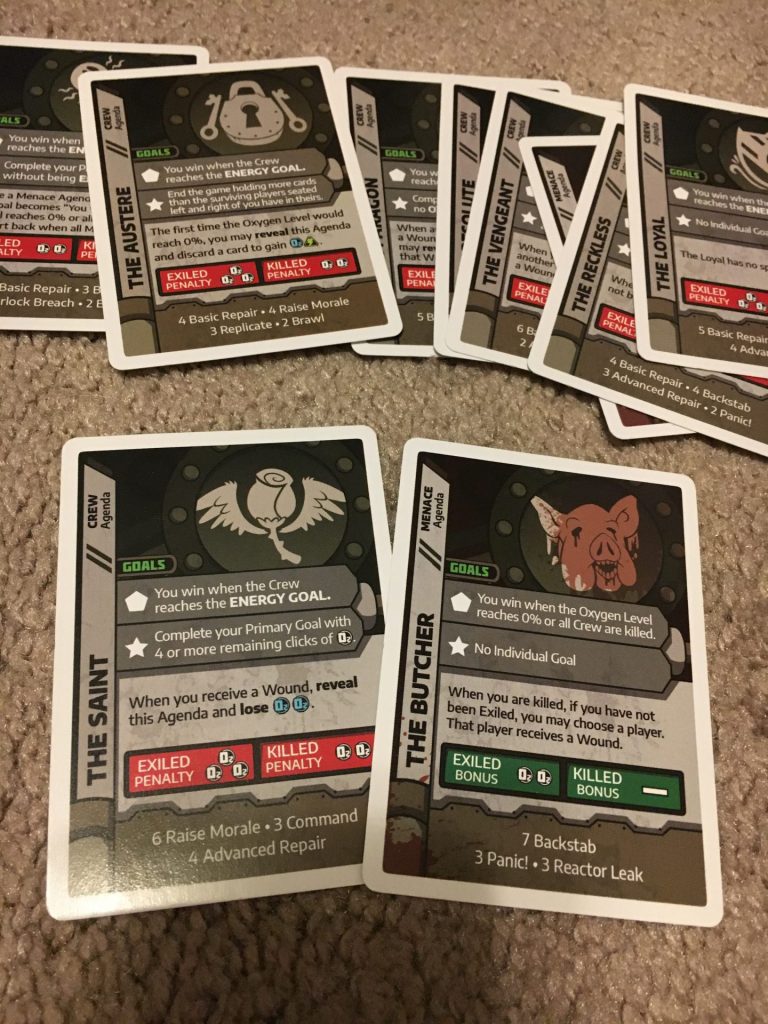
The Menace Among us is played over a series of rounds where each player has a unique character with special abilities and a role that lays out how they play the game. Both the role and character come with a set number of specific Below Deck action cards which are combined to create your 20 card action deck. These cards can be played and will contribute to a collective “action deck”. Cards revealed from the action deck will offer a number of different options, and will adjust the resources on the ship or even wound the crew themselves. We will dive more into the cards later but for now the thing to know is that a huge plus of The Menace Among Us is that each role and character combo is unique both in available cards and character abilities.
Once each player has either played a card or activated their special ability, the first player that round will collect all of the cards, shuffle them and reveal the effects. Once all the effects are revealed there will be an opportunity to accuse, vote and exile one player if a majority of the group feels they are a Menace. But beware…exile is no light decision. If you exile a loyal crewmember you will lose a great deal of oxygen in the process; more about this in just a moment.
Show me Your Skills
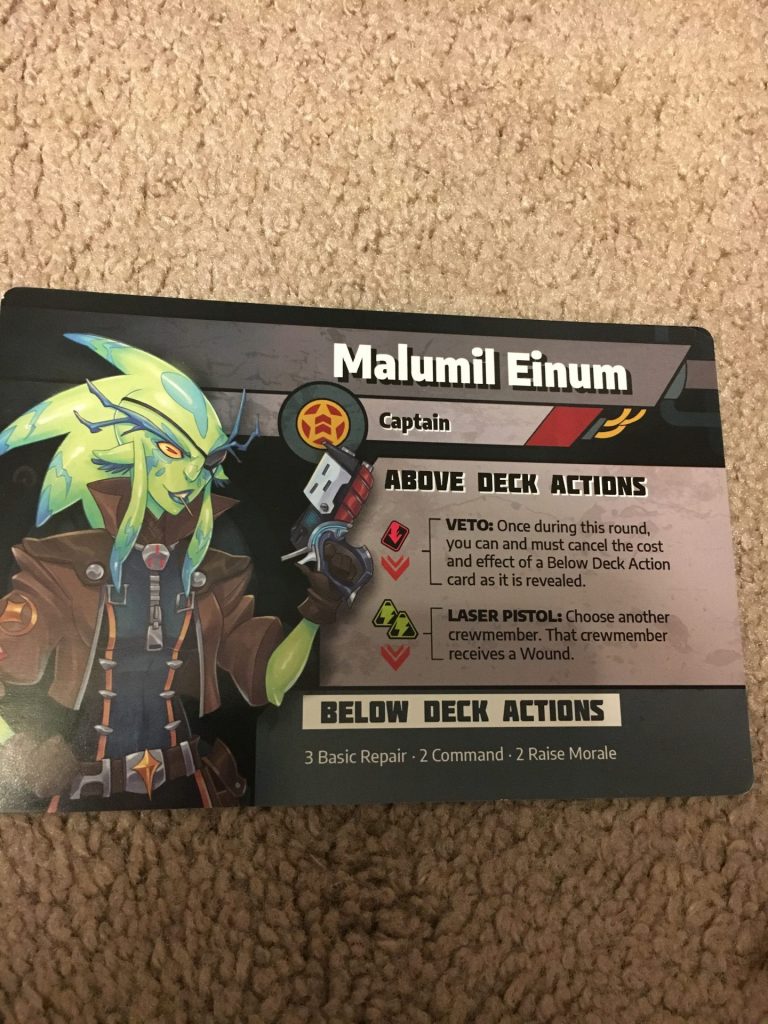
Each character has two abilities that are unique to them. They cost a varying number of cards, energy or even oxygen to perform but are very powerful when used correctly. On your turn instead of playing a card to the action deck, you can use one of your Above Deck abilities instead. These abilities range from drawing cards or healing injuries, to stealing the ship’s energy, to straight up shooting someone with your blaster to injure them (guns are not toys kids!).
Along with giving you some asymmetry and powerful skills, the Above Deck abilities add a great layer of social interaction. You do not have to just rely on your word or bluffing from the face-down cards to push your agenda. You can “prove” you are “helping” by taking Above Deck abilities that are clear and visible to every player. In a game like The Resistance, your words are your only definitive tools to demonstrate your allegiances. In The Menace Among Us, the unique powers give players the tools to make big statements about what side they’re on — whether they’re faking it or not.
Many of the assigned “roles” also have some kind of passive or special ability that activates upon being wounded, exiled or killed, as well as a secondary objective that you need to meet to actually “win” the game. All of this provides a good deal of replayability and asymmetry.
The Heart of the Cards

The Below Deck action cards make up the heart of the gameplay in The Menace Among Us. These are the “actions” that will help get your ship operational again, or perhaps leave you bleeding and gasping for air in the void. As mentioned previously, each character brings an asymmetric selection of cards to bear that are combined from both their secret role and their character. Action cards are generally broken down into three basic categories: good, bad and neutral.
The Good
These are the cards you are looking for. As a loyal crew member, which of course you are, these cards will give you the items you need to repair the ship and keep your crew alive long enough to get yourself out of this mess. They allow you to repair the ship, or increase the energy levels, or even allowing every other player to draw a card, keeping everyone’s hand economy going. Good cards often have no draw back or a very minor one far outweighed by the good it brings to the table.
The Bad
These cards are mean. Almost without exception, if you play one of these cards you are indeed a menace to society and by no means “helping.” These cards will aid you, terrible person that you are, in offing the rest of the crew and helping you achieve your goal. Most bad cards reduce a resource or deal wounds to players. All of this moves the crew closer to defeat.
The Neutral
These cards are, well, neutral. Much like a garden rake, if used correctly it can help you accomplish a great goal or if used incorrectly and set out where you can step on it, will result in a very sore nose indeed. These cards can duplicate other card effects, cost the crew cards (or gain them back). Most of these effects are up to chance since they can help or hinder based on some luck. They add a great bit of tension to the game though because you never know what to expect when these cards are in the mix.
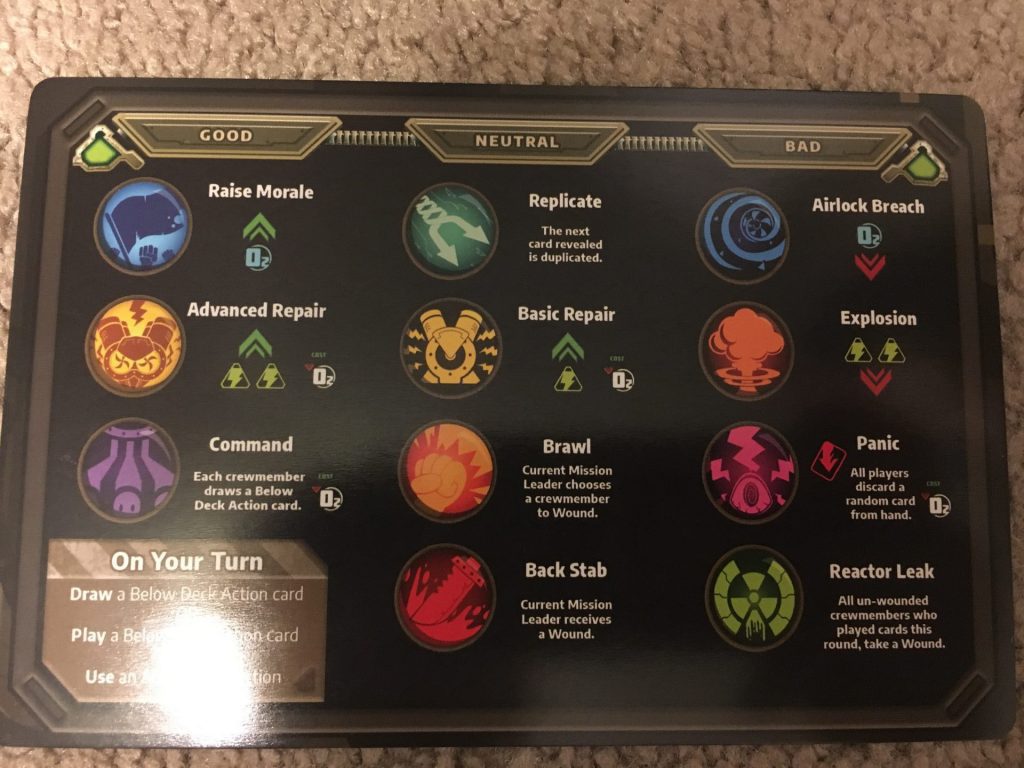
T-minus 10…9…8…
Now that we have covered the components and basic structure of the game, let’s dive deep into the rounds of play. Each round the lead player will reveal the Below Deck action cards for the round. Starting with lead player and going clockwise, each player must either play a card facedown, use one of their character abilities, or draw a card. It is important to note that in The Menace Among Us you do not get to freely draw cards, so without a bit of help, it can be difficult to keep your hand size up. Many abilities help with this but if you do not possess one you may need to rely on less-than-trusty teammates for assistance.
Once each player has performed their one action, count the cards to make sure there are a number of cards equal to at least half of the characters that started the game. If there are less, you will pull cards to meet the minimum number needed from EMMA, the ship’s AI. She has a random smattering of every card in the game, so she will try to help… but may literally stab you in the back instead. It is not great to rely on EMMA as not only are the results 100% random, it messes up your ability to read who could have played what unless you can draw patterns from previous rounds. As a game mechanic, though, this works great to throw suspicion on innocent parties: bad luck EMMA draws can make your friends seem more evil than they already are. This allows the social deduction aspect of the game to bloom in a beautiful way.
Now the cards are revealed and effects are applied. This phase allows for any number of accusations and threats to be tossed around. If you feel you have found a Menace however, the only real way to start a vote is to grab the laser pistol from the table and point it at the person you accuse. At this time a real vote to exile begins.
On a count of three, each other player not holding the gun will either point to the player they wish to exile, or simply make a fist to abstain from voting. If more players are pointing at a single-player than are abstaining or voting for someone else, that player is exiled. Even though a vote has occurred, it is still possible for no one to be exiled. If more players abstain from voting or there is a tie on who should be exiled, no one gets sent to the brig. When a player is exiled, they will reveal their role card and apply a bonus or penalty based on whether they were loyal, neutral or a menace. The most noteworthy is that if you exile a loyal character you will lose oxygen but exiling a menace will gain you oxygen. (They were breathing heavy I guess?)
Exiled players can only play cards and not use their character abilities for the rest of the game. They can still be wounded and killed even while exiled but it is a great way to verify if someone is good or bad before committing to knock them out of the game entirely. Since you can still receive wounds when exiled, two wounds will put you out of the game watching your friends and enemies carry on from beyond. Even dead you’re not totally out of the running; you can win the game even if you were killed. After this the next player becomes leader and you start this process over from the top.
The game will continue until the oxygen reaches zero for a menace victory or energy reaches the correct amount for a loyal victory.
It’s the Final Countdown!

The Menace Among Us hits all of the right buttons for me as a social deduction game. The theme, quick turn options, and variability offer a lot of value and replayability. While social deduction is always a beloved category to me, The Menace Among Us wins bonus points for its creative take on character asymmetry. The fact that your card deck is built from both your role and character means that the game goes beyond just being good or evil… there are so many different styles of both. The menace captain will not play the same as the menace cook and that is a very good thing. This keeps gameplay fresh and helps remove some “stereotypical” good guy or bad guy plays, which is important in a bluffing game such as this.
Also, I took immediate note of how much empty space there is in the main box which gives me the sneaking suspicion that there are expansions on the way. This could be easily done in both modular board changes and new cards and characters which would expand your gameplay options greatly. As always, with social game of this type, I do have to say the enjoyability of this game swings greatly based on the number of players and even more so by who those players are. It really does take the “right group” to really bring out the best of these games stunning features as it is very focused on “take that” player interaction.
All of that to say, if you are looking to add a fun, space-themed traitor game to your collection I may have a suggestion for a great game you should consider. (Psstttt — it’s The Menace Among Us!) If you are looking for other great space games check out a stellar article here.
Genre: Social Deduction
Pros: creative asymmetry, quick turn structure, limitless expansion potential, high player interaction
Cons: vulnerable to the temperament of your “game group” , High player interaction
Rating: 7.5/10 (The space replacement for Secret Hitler? )


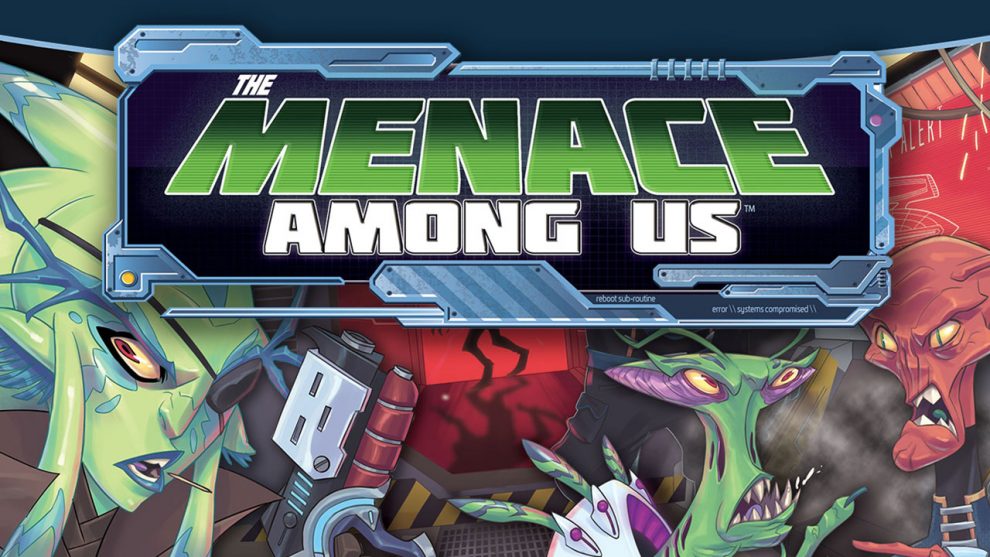

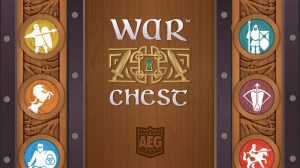






Add Comment